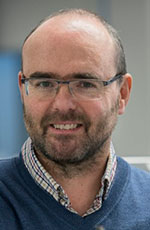The interesting facet in searching for diamonds, according to University of Alberta expert Graham Pearson, is you don’t actually look for diamonds, you look for indicator materials that suggest they might be present.
The same could be said for how mineral exploration and mining companies use the U of A to top up their workforce.

“It suddenly dawned on me that what we’ve established is something where our students get a wonderful opportunity to work with industry, and at the same time they get amazing opportunities to make groundbreaking science discoveries, some of which are used by the industries that they’re working with,” said Pearson, researcher in the Faculty of Science and Canada Excellence Research Chair Laureate in Arctic Resources.
“What we’ve established at the University of Alberta is really the world’s largest group of young researchers – students and post-docs – focused on research and exploration for diamonds and kimberlites.”
In the last couple of years, these researchers have made discoveries that improve diamond exploration as well as our understanding of the deep Earth.
Most recently, U of A post-docs Adrien Vezinet and Suzette Timmerman with the assistance of industry partner Silver Range Resources, led by U of A alumnus Mike Power – found diamond in rock of an outcrop atop an unrealized gold deposit in Nunavut that has exciting similarities to rocks that host the world’s richest gold mine, the Witwatersrand Basin gold deposits in South Africa.
Diamonds found in Far North offer clues to Earth’s early history by Michael Brown
One grad student developed a method for identifying a type of garnet mineral that’s an indicator of kimberlites and diamonds. “The methods that he produced were picked up and are being used straight away by industry,” said Pearson.
Students have also discovered three new minerals, including goldschmidtite – named in honour of Victor Moritz Goldschmidt, the founder of modern geochemistry – found inside a diamond unearthed from a mine in South Africa.

As well, recent U of A grad Margo Regier made headlines when she published a paper in Nature, documenting for the first time the full extent and operation of a super-deep carbon cycle inside Earth.
“What makes Graham’s research group so special is the large number of people invested in this group and the high-quality analytical facilities,” said Vezinet. “It’s certainly among the top three for sure, if not the top diamond group on the planet.”
At the centre of all this discovery is the Diamond Exploration and Research Training School, known as DERTS, which was launched in 2016 thanks to funding from NSERC’s Collaborative Research and Training Experience Program and an aggregation of top industry partners committed to working with students on prospecting new mines and growing Canada’s $2.5-billion-a-year diamond industry.

Timmerman, who came to the U of A on a prestigious Banting Postdoctoral Fellowship from Australia to continue her work sourcing the carbon that makes diamonds up to 700 km beneath Earth’s crust, said what sets the DERTS diamond program apart is the number and intensity of each internship.
“This is different from any other PhD program, where there is no internship or only one at most.”
Recognizing the value of his own U of A geology education, Rob L’Heureux, a vice-president at Apex Geoscience, one of the leading geological consultancies in North America, has counted on DERTS to supply student interns, who more often than not turn into employees when they graduate.
“The students that come out of the U of A bachelor of science and geology programs are pretty well rounded, so we’re able to bring them into the field and help mould that aspect of their education,” he said.

“That’s been our mentality for decades – we bring people on as students, they do three or four months’ field work during the summer and go back to school. That’s a really good test of what you might expect out of them, and the good ones you keep bringing back.”
Garrett Harris, who has the distinction of being the first student to graduate from DERTS back in 2018, spent 10 weeks with the Alberta Geological Society to wrap up his master’s degree before joining APEX Geoscience.
Harris said he was interested in getting into mineral exploration and looking for something with an economic portion to it, rather than a straight academic background.
“The DERTS program was a big draw because they offer that industry experience and allow you to get your foot in the door.
Besides the field work, Harris said a series of workshops ranging from working with Indigenous groups to logging kimberlite core has been invaluable.
“The program really exposes you to a lot of industry professionals and allows you to make those contacts that are needed to work in the world,” he said. “It really helped me start my career off running.”
Not only does this relationship benefit industry, but Pearson said it’s the post-docs and grad students who are at the heart of all his research and who make things happen.
“They’re the ones that do the work,” he said. “I have the hunches, and I bring in the research money, but it’s actually the students and post-docs who do the real nitty-gritty research. They’re essential to our success.”
| By Michael Brown
Folio, a Troy Media content provider partner, is the University of Alberta’s online publication.
The views, opinions and positions expressed by columnists and contributors are the author’s alone. They do not inherently or expressly reflect the views, opinions and/or positions of our publication.
